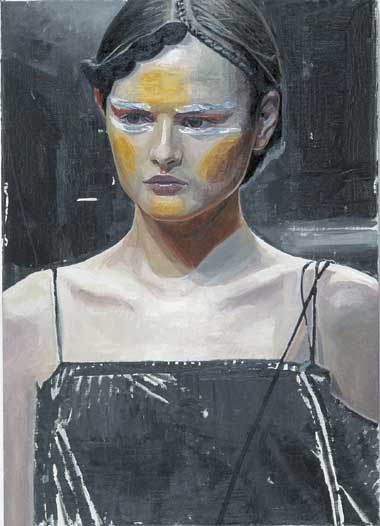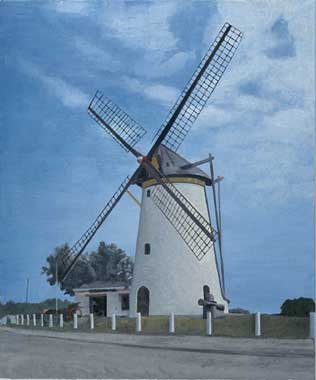Painting is slow: it does not have the vitesse of photography, and it has failed to circumvent the craft necessary to its production. This ‘tardiness’ has often been seen as the main reason for the demise of painting vis à vis the development of those modern reproductive technologies that have now replaced it as the common currency of everyday visual exchange. This has been the recurrent ‘crisis’ of modern painting, and reactions to it have been miscellaneous. To claim, however, that painting is ‘dead’, or at least anachronistic (often more assumed than openly declared), is a dead end: not only does the language of painting suffuse the discourse surrounding most art practices, but paintings themselves remain rare, unique objects that have a very restricted usage (no Rembrandts were ever used as ironing boards, alas). This means that they stand somewhat outside the flux of institutional discourses and practices that constitute the contemporary art world. Faced with the fact that painting might be superfluous, one must have faith in its capabilities and doubt of its possibilities. This peculiar mixture of faith and doubt comes to the fore when paintings overtly use photographic imagery, such as those by Mark O’Kelly, and it is, perhaps, the tension between the two parts of the mixture that enables painting to disclose the construction of meaning in images; something that photographs, for the most part, cannot do.
 |
| Mark O’Kelly: New Amsterdam, oil on linen, 2004; courtesy Kevin Kavanagh Gallery |
As Roland Barthes once said, photographs establish an awareness of the thing “ having-been-there," making “an illogical conjunction between the here-now and the there-then ." Such pretence of ‘naturalness’, returning one to an event that ‘actually happened’, masks the construction of meaning in the image, and, by the same token, disguises evidence of intention or agency (this is not to deny self-reflexivity to photographs, only that they still possess an ideological power dependent upon their assumed authority as a record). Painting from photographs and photocopies is at a second remove from the there-then, and this slight distance allows meanings in the painted image to become unfixed, exposing undercurrents that were obscured.
 |
| Mark O’Kelly: The Americas, oil on linen, 2004; courtesy Kevin Kavanagh Gallery |
These undercurrents can be narratives: not only those of the situation that the source photograph refers back to, they can also be added by the artist and manipulated, both within each painting and between works placed together in a show. In O’Kelly’s paintings, a rather subtle iconography running through the works makes reference to current world events and political tendencies, but withholds any definite viewpoint upon them. For example, in this exhibition there are two towers, and the audience in New Amsterdam is from the New York fashion show days after the attacks on the World Trade Centre; there are signs of militarisation (a parade, a discreet cannon) and uniformity; there is possible reference to bland, corporate capitalism and its expansionist agenda (e.g. the recurring interventions of the United States in the political affairs of its southern neighbours, reinforced, bizarrely, by the alleged neutrality of cartography, which shows that Latin America is ‘below’ its northern neighbour); and there is what might be either pristine rainforest or, on second viewing, potted palms in a hothouse (the latter a more suitable setting for the model in Yohji, perhaps). All these references and more are brought to play, connecting the works in an intricate web of interpretations, or what Yvonne Scott likens to “Chinese whispers." However, whilst one can, of course, play the game, emphasising this web of references to current events is to read these paintings still as one would photographic reportage, and thus to make painting subservient to photographic criteria.
 |
| Mark O’Kelly: Yohji, oil on linen, 2004; courtesy Kevin Kavanagh Gallery |
If O’Kelly’s paintings are considered in the terms above, they seem rather underdeveloped. There is a politics and a history to the activity of looking, and to the conceptual organisation of a picture space. There has been, among other approaches, a ‘politicised pictorialism’ (e.g. Terry Atkinson) that seeks to address principles of engagement and visual attention, and how these are crossed by class, gender, ideology and so on.
There is another, more material reality to O’Kelly’s works, which is that of paint and its capacity to picture a world. And if painting is twice removed from the there-then, if it is most emphatically here-now, then it is a double negation: that is, it negates the first negation of painting by photography. Like certain of Gerhard Richter’s paintings, O’Kelly’s chronicle the impasse of a double negation by ‘marking time’, refusing to see negation as an end; hence, they are rather melancholic (despite O’Kelly’s obvious sense of humour). Time is ‘marked’ by the application of paint; methodical and even in both Richter’s and O’Kelly’s work.
This impasse is given an unexpected twist in Old Holland, where the windmill logo from tubes of ‘Old Holland’ oil paint is remade into a painted image of Old Holland. The painting here paints its own idealised and commodified image. The reproduction and circulation of images and references here short-circuits, causing it to ‘stall’ for a moment.
 |
| Mark O’Kelly: Old Amsterdam, oil on linen, 2004; courtesy Kevin Kavanagh Gallery |
What of paint’s capacity to picture a world? It might be thought that most of the works here are ‘incomplete’. For instance, one might read Parade as a witty play on models and modelling: what happens to models when they are incompletely modelled, when they are seen before they have ‘put a face on’? (They become monstrous.) However, ‘incompletion’ here means that they are different from what they are assumed to represent. But, to paraphrase Richter, if paintings are not made for purposes of comparison with reality, they cannot be different (or incomplete) – different from what? Reality? But reality must be pictured, and perhaps paintings show that picturing. If painting is an act of picturing it loses its capacity to be re presentative, or indeed, expressive, because it presents only itself, as a craft. The uniqueness of painting’s craft and its capacity to picture a world have both been deployed in recent years to revitalise painting, often with an emphasis on the expressive potential of paint, but O’Kelly’s rather deadpan facture permits no return on this recurrent ideological investment in painting’s expressivity: it avoids any fetishisation of facture as the trace of human essence and authentic expression. At this point paint ‘fails’ to communicate – it has nothing to say and is saying it.
This failure to communicate does not give these works some analytical distance, nor does it allow the viewer to be ‘detached’ (such an elevated position is dependent upon a denial of privilege, and, strictly speaking, impossible). If there is such an absence of meaning, painting would preclude received ideas and their attendant positions.
Tim Stott is an art critic living in Dublin.